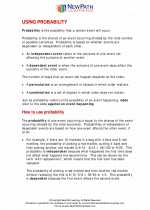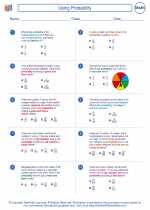Using Probability
Probability is a branch of mathematics that deals with the likelihood of a given event or outcome occurring. In everyday life, we use probability to make decisions, predict outcomes, and understand uncertainty. Understanding probability can help in making better decisions and analyzing various situations.
Key Concepts
- Probability Scale: Probability is measured on a scale from 0 to 1, where 0 indicates impossibility and 1 indicates certainty.
- Sample Space: The set of all possible outcomes of a random experiment is called the sample space.
- Events: An event is a subset of the sample space, representing a specific outcome or a set of outcomes.
- Probability of an Event: The probability of an event A, denoted as P(A), is the likelihood of event A occurring and is a number between 0 and 1.
- Addition Rule: For any two events A and B, the probability of the union of A and B is given by P(A ∪ B) = P(A) + P(B) - P(A ∩ B).
- Multiplication Rule: For independent events A and B, the probability of the intersection of A and B is given by P(A ∩ B) = P(A) * P(B).
Study Guide
When studying probability, it's important to understand the basic concepts and rules. Here are some key steps to follow:
- Understand the probability scale and how to interpret probabilities.
- Learn to identify the sample space and events for a given scenario.
- Practice calculating the probability of simple and compound events using the addition and multiplication rules.
- Work on problems involving dependent and independent events.
- Use tree diagrams, tables, and probability models to visualize and solve probability problems.
- Apply probability concepts to real-life situations, such as games of chance, weather forecasts, or business decisions.
Remember to practice solving a variety of probability problems to strengthen your understanding of the concepts. Additionally, understanding the application of probability in different contexts will help you appreciate its significance in various fields.
Good luck with your study of probability!
[Using Probability] Related Worksheets and Study Guides:
.◂Math Worksheets and Study Guides Seventh Grade. Using Probability
Study Guide Using Probability
Using Probability  Worksheet/Answer key
Worksheet/Answer key Using Probability
Using Probability  Worksheet/Answer key
Worksheet/Answer key Using Probability
Using Probability  Worksheet/Answer key
Worksheet/Answer key Using Probability
Using Probability 

 Worksheet/Answer key
Worksheet/Answer key
 Worksheet/Answer key
Worksheet/Answer key
 Worksheet/Answer key
Worksheet/Answer key

The resources above cover the following skills:
Data Analysis and Probability (NCTM)
Understand and apply basic concepts of probability
Compute probabilities for simple compound events, using such methods as organized lists, tree diagrams, and area models.